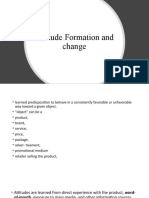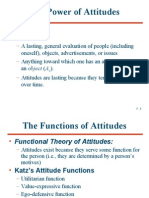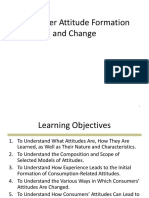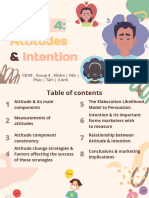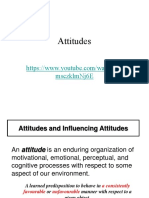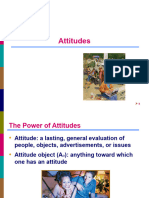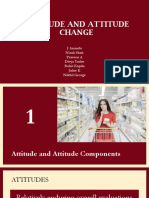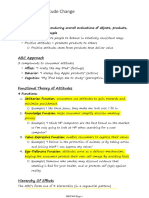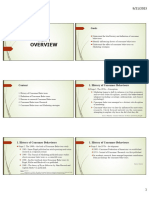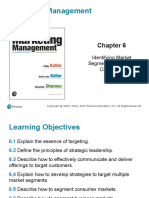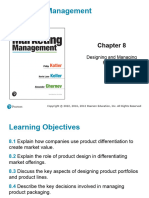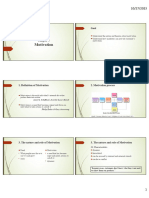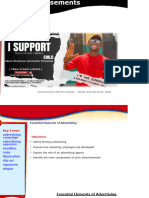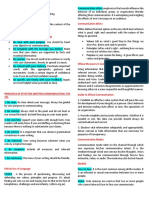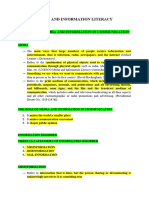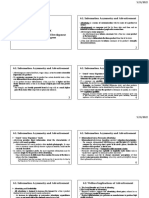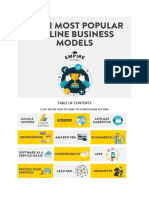11/15/2023
Goals
Understand the nature and components of attitudes
Explain methods of changing attitudes
Chapter 7 Apply attitude and attitude change in marketing
Attitude and persuasion
Content 1. Definition of Attitude
1. Definition of attitude
An attitude is a lasting,
2. Attitude functions general evaluation of
3. Attitude components people (including oneself),
4. How attitude is formed objects, advertisements or
issues
5. How to change attitude
Solomon
6. Application of attitude in Marketing
1. Definition of Attitude 2. Attitude functions
The nature of attitude: utilitarian function
Aiming for a certain target value-expressive function
Relatively stable for familiar things ego-defensive function
Difficult to change knowledge function
1
� 11/15/2023
2. Attitude functions 2. Attitude functions
Utilitarian function Value-expressive function
1. Attitude 2. Attitude functions
1.3. Functions of attitude 1.3. Functions of attitude
ego-defensive function knowledge function: applies when a person is in an
ambiguous situation or confronts a new product
3. Attitude components 3. Attitude components
- sympathetic nervouse system
Affects reactions
Cognition Stimuli - affective verbal statements
(personal stimuli,
situations, social
- sensory reactions
problems, social Attitude Cognition
- verbal statements about belief
groups and
otherattitude
targets) - public actions
Affects Behaviours Behavior
- verbal statements about
tendency
behaviours
2
� 11/15/2023
3.1 Affects (emotions) 3.1 Affects (emotions)
Customers tend to get attached to a brand once it manages
to “touch” their emotions.
3.2. Cognition
What consumers believe to be true about the attitude object
3.3. Behaviours
Cadillac Escalade
Infinity QX56
Lexus LX570
the actions that consumers take toward an object
Lincoln Navigator
Toyota Land Cruiser
Land Rover
Range Rover
3
� 11/15/2023
3.4 Hierarchies of Effects 3.4 Hierarchies of Effects
High-Involvement Hierarchy
High-Involvement Hierarchy
Low-Involvement Hierarchy
Experiential Hierarchy Attitude
based on the
Think Feel Do processing
(Cognition) (Affects) (Behaviours) of cognitive
information
3.4 Hierarchies of Effects 3.4 Hierarchies of Effects
Low-Involvement Hierarchy Experiential Hierarchy
Attitude Attitude is
based on the based on the
Think Do Feel behavioral Feel Do Think experience
(Cognition) (Behaviors) (Affects) learning (Affects) (Behaviors) (Cognition) of
process excitement
4. How attitude is formed 4. How attitude is formed
We form an attitude in several different ways, depending on the Principle of cognitive consistency: we value harmony among our
particular hierarchy of effects that operates. thoughts, feelings, and behaviors, and a need to maintain uniformity
Consumers’ commitment to an attitude: among these elements motivates us.
• Compliance - to gain rewards or avoid punishment. This attitude Self-perception theory: we maintain consistency as we infer that
is superficial. we must have a positive attitude toward an object if we have bought
or consumed it
• Identification - to conform to another person’s or group’s
expectations Foot-in-the-door technique: They know that consumers are more
likely to comply with a big request if they agree to a smaller one
• Internalization -deep-seated attitudes become part of our value first
system
4
� 11/15/2023
4. How attitude is formed 4. How attitude is formed
Balance theory Multiattribute Attitude Models
Ajk =∑βijkIik
i = attribute
j = brand
k = consumer
I = the importance weight given attribute i by consumer k
b = consumer k’s belief regarding the extent to which brand j possesses
attribute i
A = a particular consumer’s (k’s) attitude score for brand j
Example 4. How attitude is formed
Attribute Smartphone A Smartphone B Smartphone C Do Attitudes Predict Behavior?
Screen (20%) 8 9 6 The theory of reasoned action
Design (10%) 10 7 8
Memory capacity 9 10 7
(25%)
Battery life (20%) 8 7 9
Speed (25%) 7 9 8
Evaluation score 8.2 8.65 7.55
(attitude)
5. How to change attitude 5. How to change attitude
5.1 Changing the cognitive element 5.1 Changing the cognition element
Marketing Applications of the Multiattribute Model brand attributes
• Capitalize on relative advantage
• Strengthen perceived product/attribute linkages
• Add a new attribute
• Influence competitors’ ratings
5
� 11/15/2023
5. How to change attitude 5. How to change attitude
4.1 Changing the cognition element 5.2 Changing the affective element
adding new attributes Application of classical conditioning (using celebrities or
KOLs)
Changing consumers’ feeling through advertisements
üemotional/fear/humor appeals
üsex appeals
4. How to change attitude
Humorous advertising Humorous advertising
6
� 11/15/2023
Comparative advertsing 5. Ways to change attitude
5.3 Changing the behavioral element
Application of operant conditioning
5. Ways to change attitude 5. How to change attitude
5.4 Basic psychological principles for persuasion 5.4 The Elements of Communication
Reciprocity—We are more likely to give if first we receive. Source: credibility, attractiveness
Scarcity—Like people, items are more attractive when they aren’t Message: picture vs words, repetition, format, appeals
available. Source vs Messsage: The Elaboration Likelihood Model (ELM)
Authority—We believe an authoritative source much more readily than • high involvement: central route. When we find the information in a
one that is less authoritative. persuasive message relevant or interesting, we pay careful attention
Consistency—People try not to contradict themselves in terms of what to it
they say and do about an issue. • low involvement: peripheral route. When we don’t care as much
Liking—We agree with those we like or admire. about a product, the way it’s presented increases in importance
Consensus—We consider what others do before we decide what to do.
6. Marketing application based on attitudes 6. Marketing application based on attitudes
6.1. Market segmentation 6.1. Market segmentation
• the multiattribute attitude model → segmenting by • the value-expressive function → psychographic
benefits sought segmentation
7
� 11/15/2023
6. Marketing application based on attitudes Discussion
6.2. Marketing strategies to change attitude 1. Provide an example of an advertisement that you believe
• Cognition → product attributes to be very successful in raising customers’ sense of humor of
fear
• Affects → classical conditioning & emotional appeal
• Behaviour → operant conditioning 2. In your opinion, is using celebities to deliver product
messages to consumers able to orientate the consumers’
• Characteristics of the source and message
attitude towards a product or brand?
• Native advertising → make your ad look natural and not annoying for
audience
Discussion
3. Think about foodstalls/restaurants you like and do not like
to patronize. Design a multi-attribute model for the two
restaurants, making sure both spectrums are included. Make
suggestions of how the managers could improve the
restaurants’ images by following the strategies and tactics
found in this chapter









